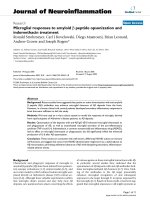Báo cáo hóa học: " Template Route to Chemically Engineering Cavities at Nanoscale: A Case Study of Zn(OH)2 Template" doc
Bạn đang xem bản rút gọn của tài liệu. Xem và tải ngay bản đầy đủ của tài liệu tại đây (778.85 KB, 9 trang )
NANO EXPRESS
Template Route to Chemically Engineering Cavities at Nanoscale:
A Case Study of Zn(OH)
2
Template
Dapeng Wu
•
Yi Jiang
•
Junli Liu
•
Yafei Yuan
•
Junshu Wu
•
Kai Jiang
•
Dongfeng Xue
Received: 17 June 2010 / Accepted: 19 July 2010 / Published online: 1 August 2010
Ó The Author(s) 2010. This article is published with open access at Springerlink.com
Abstract A size-controlled Zn(OH)
2
template is used as
a case study to explain the chemical strategy that can be
executed to chemically engineering various nanoscale
cavities. Zn(OH)
2
octahedron with 8 vertices and 14 edges
is fabricated via a low temperature solution route. The size
can be tuned from 1 to 30 lm by changing the reaction
conditions. Two methods can be selected for the hollow
process without loss of the original shape of Zn(OH)
2
template. Ion-replacement reaction is suitable for fabrica-
tion of hollow sulfides based on the solubility difference
between Zn(OH)
2
and products. Controlled chemical
deposition is utilized to coat an oxide layer on the surface
of Zn(OH)
2
template. The abundant hydroxyl groups on
Zn(OH)
2
afford strong coordination ability with cations
and help to the coating of a shell layer. The rudimental
Zn(OH)
2
core is eliminated with ammonia solution. In
addition, ZnO-based heterostructures possessing better
chemical or physical properties can also be prepared via
this unique templating process. Room-temperature photo-
luminescence spectra of the heterostructures and hollow
structures are also shown to study their optical properties.
Keywords Template Á Zn(OH)
2
octahedron Á
Ion-replacement reaction Á Chemical deposition
Introduction
Owing to the potential applications in the fields of drug
delivery, catalysis, artificial cell, lightweight fillers and
protection for the light- or chemical-sensitive materials,
hollow structures have received increasing research inter-
ests [1–6]. So far, hollow structures have been synthesized
by means of various methods, among which template
directing is the most straightforward way to yield hollow
structures effectively. The commonly used templates
include polystyrene (PS) latex spheres, silica spheres,
carbon colloid spheres, gas bubbles and emulsion droplets
[7–13]. Self-template routes by Kirkendall effect and
Ostwald ripening have also been applied to realize hol-
lowing process [14–17]. However, the general synthesized
hollow products are mostly spheres. Although several
previous works have been devoted to synthesize non-
spherical hollow structures [18–22], it still remains a
challenge to fabricate well-defined nonspherical hollow
structures especially with tunable size.
ZnO has drawn great attention due to its applications in
short wave length photonic devices [23–27]. In this paper,
we design a general strategy to fabricate nanoscale cavity
in functional materials. Zn(OH)
2
octahedron template is
taken as a case study, as shown in Fig. 1. Zn(OH)
2
octahedra with controllable diameters were first prepared
in low temperature aqueous solution. A series of ZnO-
based heterostructures and octahedral hollow structures
were then fabricated by using Zn(OH)
2
octahedra as
promising sacrificial template. Taking advantage of the
inherent properties of this hard template, two strategies
were applied to construct hollow structures. ZnS and
Ag
2
S hollow octahedra were obtained via chemical con-
version. SiO
2
and CeO
2
hollow octahedra were synthe-
sized through a controlled deposition. Moreover, the
D. Wu Á Y. Jiang Á J. Liu Á Y. Yuan Á K. Jiang (&)
College of Chemistry and Environmental Science, Henan
Normal University, 47 Jianshe Road, 453007 Xinxiang, China
e-mail:
J. Wu Á D. Xue (&)
Department of Materials Science and Chemical Engineering,
School of Chemical Engineering, Dalian University of
Technology, 158 Zhongshan Road, 116012 Dalian, China
e-mail:
123
Nanoscale Res Lett (2010) 5:1779–1787
DOI 10.1007/s11671-010-9711-1
diameters of the Zn(OH)
2
octahedron can be easily tuned
from *1to*30 lm, which makes it a promising tem-
plate to synthesize a wide range of octahedral hollow
structures with tunable sizes.
The merits of using Zn(OH)
2
as template are as follows:
(1) it provides a unique template to synthesize nonspherical
hollow structures; (2) the good solubility of Zn(OH)
2
facilitates the surface chemical conversion; (3) owing to its
inherent amphoteric habit, both alkaline and acid solution
can be used to remove the inner core according to the
nature of the outside coating materials; (4) due to the
abundant hydroxyl groups which exhibit strong combining
ability, positive charged metal cations could be enriched on
the surface of the template without surface modification;
(5) the diameter of the template can be tuned from *1to
*30 lm by slightly altering the reaction condition.
Moreover, after a low temperature calcination (135 °C),
this Zn(OH)
2
template can be easily converted into ZnO
crystal, which can transform the intermediate Zn(OH)
2
/
shell structures into ZnO-based heterostructures. Therefore,
Zn(OH)
2
octahedra can be used as a promising hard tem-
plate for synthesizing nonspherical hollow structures and
ZnO-based heterostructures.
Experimental
(1) Synthesis of the Zn(OH)
2
template: Octahedral
Zn(OH)
2
template (3–4 lm in diameter) was obtained
using a convenient way. 0.83 g Zn(NO
3
)
2
Á6H
2
O was first
dissolved into 15 mL distilled water, and then mixed with
10 mL aqueous solution containing 0.96 g NaOH under
stirring. Then, the clear solution was placed in 50 °C water
bath for 2 h. In order to control the diameter of the tem-
plate, the reaction parameter was slightly adjusted. For
25–30 lm Zn(OH)
2
octahedron, 15 mL 0.19 M Zn(NO
3
)
2
solution was kept in ice water bath (0 °C), and then mixed
with 10 mL aqueous solution containing 0.96 g NaOH.
The solution was aged under room temperature water bath
for 2 days. For 5–7 lm Zn(OH)
2
octahedron, 15 mL
0.19 M Zn(NO
3
)
2
solution was mixed with 10 mL 0.24 M
NaOH solution. The solution was placed in 30 °C water
bath for 20 h. For 1–2 lm Zn(OH)
2
octahedron, 0.02 g
poly(vinylpyrrolidone) (PVP) was added 15 mL 0.19 M
Zn(NO
3
)
2
solution. The mixture was stirred under room
temperature for 30 min. Subsequently, 10 mL 0.24 M
NaOH solution was added dropwise. The solution was
placed in 30 °C water bath for 12 h. All the white pre-
cipitation was collected by centrifugation and washed
thoroughly with distilled water and absolute ethanol sev-
eral times. The product was dried in vacuum for 6 h at
50 °C.
(2) Synthesis of hollow structures: for ZnS hollow
structure, 200 mg Zn(OH)
2
template (3–4 lm in diameter)
was dispersed in 40 mL 0.20 M Na
2
S solution and stirred
for 12 h in a 70 °C oil bath. Then, dark gray precipitation
was centrifuged and subsequently placed in 25% (wt)
ammonia solution for 50 min under mild stirring. Finally,
the as-prepared products were centrifuged, washed with
distilled water and absolute ethanol several times. The
as-prepared sample was dried in vacuum for6 h at50 °C. For
Ag
2
S hollow structure, after the surface of the template was
sulfured by the Na
2
S solution, the participation was washed
thoroughly with water to eliminate the S
2-
in the product.
Then, the core/shell product was placed in 30 mL 0.05 M
AgNO
3
solution. The suspension was stirred for 30 min
under room temperature to obtain black products, and then
the pH value of the solutions was adjusted to 2 by several
drops of diluted HNO
3
. Another 20 min was allowed to
obtain Ag
2
S hollow octahedron. Finally, the product was
washed by water and ethanol several times and dried in
vacuum for 8 h at 60 °C. For Synthesis of SiO
2
hollow
structure, 200 mg Zn(OH)
2
template (1–2 lm in diameter)
was dispersed into 20 mL ethanol, then 9 mL water and
Zn(OH)
2
Template
Zn(OH)
2
–based
Core/shell Structure
Nanoscale
Cavity
Step 1: Chemical Deposition
Step 2: Core Removal
Step 1: Chemical Conversion with S
2−
Step 2: Cation
Exchange
Step 3: Core Removal
Process I
Process II
Fig. 1 The scheme for constructing hollow octahedron by using
Zn(OH)
2
as template. Process I: Surface chemical conversion of
Zn(OH)
2
template with S
2-
[Step 1]. Cation exchange can be
performed on the surface of Zn(OH)
2
/ZnS architectures, generating
various Zn(OH)
2
/sulfide core/shell structures [Step 2]. A core removal
results in various nanoscale sulfide cavities. Process II: Chemical
deposition on Zn(OH)
2
template [Step 1], following a core removal
step [Step 2]
1780 Nanoscale Res Lett (2010) 5:1779–1787
123
0.5 mL, 25% (wt) ammonia was added. The as-formed
suspension was placed into ultrasonic irradiation and
0.5 mL TEOS was added. The mixture was subsequently
stirred at room temperature for 3 h, the final white product
was collected by centrifugation and washed with water and
absolute ethanol for several times. The product was dried
in vacuum at 80 °C for 3 h and treated with 0.10 M HCl to
remove the inner template. The SiO
2
hollow octahedron
was collected by centrifugation, washed with water and
absolute ethanol and dried in vacuum at 80 °C for 3 h. For
Synthesis of the CeO
2
hollow structure, 200 mg as-pre-
pared Zn(OH)
2
octahedron template (1–2 lm in diameter)
was dispersed into 16 mL alcohol by ultrasonic irradiation.
Then, 2 mL double-distilled water containing 0.50 mmol
Ce(NO
3
)
3
was added. The solution was stirred for 30 min
to form a homogenous suspension. Subsequently, 5 mmol
urea was added into the suspension and stirred for another
30 min to dissolve the urea completely. Then, the sus-
pension was placed into an oil bath at 60 °C for 12 h under
vigorous stirring. The final white product was collected by
centrifugation, washed thoroughly with distilled water and
absolute ethanol several times and dried in vacuum for 5 h
at 50 °C. Then, the as-prepared product was annealed at
150 ° C for 2 h to generate light yellow ZnO/CeO
2
het-
erostructure. Finally, the heterostructure was washed with
0.10 M HCl to remove the inner ZnO core and obtain CeO
2
hollow octahedron.
Characterization
The phase purity of the products were characterized by
X-ray diffraction (XRD) patterns, using a Bruker advance-
D8 XRD with Cu Ka radiation (k = 0.154178 nm). The
accelerating voltage was set at 40 KV with a 100 mA flux.
Scanning electronic microscopy (SEM) images were taken
on JEOL JSM-6390LV. Low-magnification transmission
electronic microscopy (TEM) images were obtained from
JEOL JSM-100 while the high-resolution transmission
electron microscopy (HRTEM) and selected-area electron
diffraction (SAED) images were taken on FEI Tecnai
G220. Thermogravimetry and differential scanning calo-
rimetry (TG–DSC) of the samples were carried out with
a Netzsch STA 409 PC analyzer at a heating rate of
10 °C/min. Fourier transform infrared spectroscopy (FT-IR)
spectra were recorded on a Bio-Rad FTS-40 Fourier
transform infrared spectrometer. The photoluminescence
(PL) was performed on JASCO FP-6500 fluorophotometer
at room temperature.
Results and Discussion
Figure 2a shows a SEM image of the Zn(OH)
2
template
synthesized by decomposing the Zn(OH)
4
2-
precursor
Fig. 2 a Low- and b high-
magnification SEM images of
Zn(OH)
2
octahedra, c TEM
image d XRD patterns of
Zn(OH)
2
and ZnO
Nanoscale Res Lett (2010) 5:1779–1787 1781
123
directly in a low temperature aqueous solution (50 °C). The
diameter of the octahedra is uniform and at 3–4 lm. The
magnified image (Fig. 2b) reveals that the as-prepared
particle has unique octahedral shape with 8 vertices and 14
edges. The crystals are well defined with smooth surface,
which can be confirmed by the corresponding TEM image
shown in Fig. 2c. The XRD patterns in Fig. 2d show that
all of the diffraction peaks of the template can be perfectly
indexed to orthorhombic Zn(OH)
2
(JCPDS Card No.
74-0094). While the diffraction peaks of the annealed
sample match well with hexagonal wurtzite ZnO (JCPDS
Card No. 79-0205). The TG and DSC curves, displayed in
Fig. 3a, suggest that this template remains stable before
100 ° C and experiences a steep weigh loss around 135 °C.
The weight loss ratio is about 17.5% which accords with
theory calculation (18.3%), indicating the probable formula
for this template is Zn(OH)
2
. From the FT-IR spectrum of
the template (Fig. 3b), the strong absorption around
3,400 cm
-1
corresponds to the O–H stretching from the
hydroxyl groups located on the surface of Zn(OH)
2
parti-
cles. These hydroxyl groups exhibit good combining ability
toward the positive charged metal cations, which can lead
to the enrichment of the metal cations on the surface of the
template. Figure 3b also represents the comparative FT-IR
spectrum of the ZnO sample after calcination. The peak
around 3,400 cm
-1
is substantially abated. Though many
researches have been done to tailor the shape and size of
the materials to enrich their properties, controllable fabri-
cation still remains a big challenge in material science. The
average diameter of Zn(OH)
2
octahedra can be readily
Fig. 3 a TG and DSC curves
of Zn(OH)
2
products, b FT-IR
spectra
Fig. 4 Zn(OH)
2
with different
sizes a 25–30 lm, b 5–7 lm,
c 1–2 lm
1782 Nanoscale Res Lett (2010) 5:1779–1787
123
tuned in a large range by altering the reaction parameters.
All of the as-prepared Zn(OH)
2
octahedra are uniform and
the diameters are approximately at 25–30, 5–7, and
1–2 lm, respectively (Fig. 4). To our knowledge, this is
the first time to study the size control over Zn(OH)
2
crystal
and fabricate hollow structures by using Zn(OH)
2
octahe-
dron as sacrificing template. By using these templates, a
series of hollow structured materials with controllable sizes
can be fabricated.
Two strategies were applied to fabricate different octa-
hedral hollow structures by using Zn(OH)
2
as templates.
Transition metal sulfides were prepared through a facile
chemical conversion. Zn(OH)
2
templates were directly
immersed into 0.20 M Na
2
S solution, leading to core/shell
Zn(OH)
2
/ZnS structures (Fig. 5a), which were clearly
observed after an ammonia treatment for 10 min (Fig. 5b).
The diameter of the core/shell structure is almost
unchanged. Figure 5c shows the low magnified SEM
image, the diameter of hollow structure is 3–4 lm. From
the inset of Fig. 5c, a broken part can be seen. The hole can
serve as the entrance for sensitive materials such as med-
icine molecules or proteins. The corresponding TEM image
is depicted in Fig. 5d. The interior of the products is
completely hollowed and the shell is comprised of
numerous nanoparticles. The whole conversion process
was recorded by XRD patterns (Fig. 5e). After the core was
thoroughly removed, only ZnS diffraction peaks existed
with cell constant a = 5.406 A
˚
which is consistent with the
standard value (JCPDS Card No. 05-0566). In order to
promote the chemical conversion, high solubility
Zn
5
(CO
3
)
2
(OH)
6
was used as a sacrificing template instead
of ZnO. For the same purpose, a thioglycolic acid-assisted
route was also used to activate the Zn
2?
on the surface of
inert ZnO template [28, 29]. In our case, except the well
Fig. 5 a Zn(OH)
2
coated with a
layer of ZnS, b core/shell
structure after reacted with
ammonia for 10 min, c low-
magnification SEM image and
d TEM image of hollow ZnS
octahedra. e XRD patterns of
the products generated during
the process, f PL spectrum of
ZnS shell obtained under an
ultraviolet excitation at 350 nm
Nanoscale Res Lett (2010) 5:1779–1787 1783
123
solubility of Zn(OH)
2
(K
sp
= 1.2 9 10
-17
), the Na
2
S
solution with a high pH value (12) also played a positive
role in promoting the reactivity of the precursor by con-
verting the Zn(OH)
2
into more reactive ZnO
2
2-
on the
template surface. In the later core-removing step, ammonia
solution was used instead of the widely used NaOH or
KOH [30, 31]. Due to the strong coordination ability of
NH
3
, the core-removing duration can be dramatically
reduced. Moreover, the good volatility and solubility of
ammonia make it easier to be evacuated from the final
product. PL measurements were performed for optical
characterization of the hollow ZnS shell powder. The
sample is photoexcited at 350 nm. As shown in Fig. 5f,
two major peaks can be observed, one at 466 nm caused by
sulfur bond dangling at the interface of ZnS grains, the
other at about 548 nm, which may be originated from
surface states and various point defects. The strong-defect-
related signal implies that ZnS nanoshells contain more
defects.
During chemical conversion, the driven force for the
chemical conversion is attributed to the gap between the
solubility of Zn(OH)
2
and ZnS. ZnS crystal (K
sp
= 2.93 9
10
-25
) is more thermodynamically stable and has lower
solubility than Zn(OH)
2
, thus the conversion process
moves forward. Based on this point, the method can be also
utilized to fabricate other transition metal sulfides via a
similar chemical conversion [32, 33]. The Zn(OH)
2
/ZnS
core/shell structure was immersed into AgNO
3
solutions
to generate uniform Ag
2
S(K
sp
= 6.69 9 10
-50
) hollow
octahedra, as shown in Fig. 6a, b. The XRD pattern
(Fig. 6c) reveals that all the diffraction peaks can be
readily indexed as monoclinic Ag
2
S in good agreement
with the literature (JCPDS Card No. 14-0072). PL spec-
trum in Fig. 6d has only one emission peak at about
418 nm, indicating that these Ag
2
S shells can be good
candidates for optoelectronic applications. Therefore, it is
reasonable to deduce that, after appropriate modification to
this method, hollow octahedra of more thermodynamically
stable transition metal sulfide (e.g., CuS, Bi
2
S
3
,Sb
2
S
3
,
PbS) with a lower K
sp
than ZnS can be well obtained.
A controlled chemical deposition was also utilized to
coat a layer of silica onto Zn(OH)
2
template. The coating
technique has been detailedly described in recent work
[34]. Based on the coordination ability of the hydroxyl
groups, the mineralization of the cations can occur on the
template to form a layer of SiO
2
without additional surface
modification. After treated with diluted HCl, SiO
2
hollow
structure was generated. Figure 7a is the low-magnifica-
tion SEM image of the as-prepared SiO
2
product which is
uniform and the diameter is 1–2 lm. The magnified SEM
image (Fig. 7b) reveals the hollow interior of the octahe-
dra. Moreover, there are broken parts on the hollow par-
ticles which may serve as the intake entrance for drug
delivery or DNA storage. The thickness of the shell is
measured to be about 30 nm. Figure 7c displays a TEM
image of the products. The silica hollow structures are
octahedral in shape and the thin shell can well support the
hollow structure. ZnO/SiO
2
core/shell architectures can
also be obtained by facile heat treatment of corresponding
Zn(OH)
2
/SiO
2
precursors. ZnO and SiO
2
nanomaterials
Fig. 6 a SEM, b TEM image,
c XRD pattern (JCPDS Card
No. 14-0072) of the as-prepared
Ag
2
S hollow structure, d PL
emission spectrum of Ag
2
S shell
obtained under an ultraviolet
excitation at 365 nm
1784 Nanoscale Res Lett (2010) 5:1779–1787
123
have been of interest for construction of many gas- and
biosensing devices because of their biocompatibility, high
chemical stability, and low cost. Therefore, ZnO/SiO
2
composite structures are of great significance toward the
bio- or medical related fields. During the structural change
from bared ZnO to ZnO/SiO
2
core/shell, variation of
optical properties can be observed with PL spectra shown
in Fig. 7d. The intensity of visible emission peak at
433 nm increases sharply, suggesting important applica-
tion of ZnO/SiO
2
core/shell in photoelectric and biosensing
devices. Detailed work is being carried out to tailor the
thickness and the porosity of the silica shell for the
potential applications in drug delivery and controlled
release. In addition, taking advantage of the function
groups located on the template surface, a similar route in
an ethanol–water system could also be utilized to synthe-
size other inorganic hollow compounds [35]. For example,
CeO
2
hollow octahedra were also synthesized through a
similar method (Fig. 8), indicating the generality of the
chemical deposition route. SEM image in Fig. 8a shows
that the product consists of uniform CeO
2
hollow shells
grown in a large scale. XRD pattern in Fig. 8b is consistent
with the standard literature values (JCPDS Card No.
34-394). Under the stimulation of 310 nm laser, the PL
spectrum of the CeO
2
shells has a strong emission band
with the center at about 410 nm (Fig. 8c), which is ascri-
bed to hopping from different defect levels to O 2p band. It
is believed that these CeO
2
shells may have find potential
applications in displays, sensors, and photosensitive
devices.
Conclusions
A general template route has been designed to chemically
engineering nanoscale cavities, which provides a simple
scheme for the fabrication of highly crystalline hollow
nanostructures with tailorable size. Zn(OH)
2
octahedra
were facilely synthesized at low temperature. Then, they
were used as sacrificial template to construct octahedral
hollow structures with controlled sizes. Two strategies can
be adopted to fabricate different types (sulfides and oxides)
of octahedral hollow structures. In addition, Zn(OH)
2
can
be transformed into ZnO via a low temperature calcination.
Therefore, ZnO-based heterostructures possessing better
chemical or physical properties can also be prepared via
this facile templating process. These nanostructures can be
Fig. 7 The as-prepared SiO
2
hollow octahedra: a low and
b high magnification SEM
image, c TEM image. d PL
spectra of (a) ZnO and (b) ZnO/
SiO
2
core/shell structures
obtained under an ultraviolet
excitation at 350 nm
Nanoscale Res Lett (2010) 5:1779–1787 1785
123
of special interest for a variety of applications, including
catalysis, gas sensing, and nanoelectronics.
Acknowledgments This work was supported by the National Nat-
ural Science Foundation of China (20571025) and Henan Innovation
Project for University Prominent Research Talents (2005KYCX005).
Open Access This article is distributed under the terms of the
Creative Commons Attribution Noncommercial License which per-
mits any noncommercial use, distribution, and reproduction in any
medium, provided the original author(s) and source are credited.
References
1. V.V. Sokolova, I. Radtke, R. Heumann, M. Epple, Biomaterials
27, 3147 (2006)
2. F. Caruso, R.A. Caruso, H. Mo
¨
hwald, Science 282, 1111 (1998)
3. J. Liu, H. Xia, D. Xue, L. Lu, J. Am. Chem. Soc. 131, 12086
(2009)
4. D.E. Bergbreiter, Angew. Chem. Int. Ed. 38, 2870 (1999)
5. J. Liu, D. Xue, Adv. Mater. 20, 2622 (2008)
6. J. Liu, F. Liu, K. Gao, J. Wu, D. Xue, J. Mater. Chem. 19, 6073
(2009)
7. S.W. Kim, M. Kim, W.Y. Lee, T. Hyeon, J. Am. Chem. Soc. 124,
7642 (2002)
8. Z.Y. Guo, F.L. Du, G.C. Li, Z.L. Cui, Chem. Commun. 25, 2911
(2008)
9. K. Sablon, Nanoscale Res. Lett. 3, 265 (2008)
10. F. Gu, C.Z. Li, S.F. Wang, M.K. Lu, Langmuir 22, 1329 (2006)
11. B. Khlebtsov, L. Dykman, V. Bogatyrev, V. Zharov, N. Khlebt-
sov, Nanoscale Res. Lett. 2, 6 (2007)
12. A.M. Collins, C. Spickermann, S. Mann, J. Mater. Chem. 13,
1112 (2003)
13. W.J. Li, X.X. Sha, W.J. Dong, Z.C. Wang, Chem. Commun. 20,
2434 (2002)
14. H.J. Fan, M. Knez, R. Scholz, D. Hesse, K. Nielsch, M. Zacha-
rias, U. Gosele, Nano Lett. 7, 993 (2007)
15. Y.D. Yin, C.K. Erdonmez, A. Cabot, S. Hughes, A.P. Alivisatos,
Adv. Funct. Mater. 16, 1389 (2006)
16. P. Ghosh, T. Soga, K. Ghosh, T. Jimbo, R. Katoh, K. Sumiyama,
Y. Ando, Nanoscale Res. Lett. 4, 1171 (2009)
17. H.G. Yang, H.C. Zeng, J. Phys. Chem. B 108, 3492 (2004)
18. S. Jiao, L. Xu, K. Jiang, D. Xu, Adv. Mater. 18, 1174 (2006)
19. I. Avramov, Nanoscale Res. Lett. 2, 235 (2007)
20. X.W. Lou, C. Yuan, Q. Zhang, L.A. Archer, Angew. Chem. Int.
Ed. 45, 3825 (2006)
21. K.S. Krishna, G. Vivekanandan, D. Ravindera, M. Eswara-
moorthy, Chem. Commun. 46, 2989 (2010)
22. H.G. Yang, H.C. Zeng, Angew. Chem. 116, 6056 (2004)
23. J. Wu, D. Xue, Mater. Res. Bull. 45, 295 (2010)
24. J. Wu, D. Xue, Mater. Res. Bull. 45, 300 (2010)
25. P. Lu, D. Xue, Surf. Rev. Lett. 17, 261 (2010)
26. J. Wu, D. Xue, Mod. Phys. Lett. B 23, 3943 (2009)
27. C. Yan, J. Liu, F. Liu, J. Wu, K. Gao, D. Xue, Nanoscale Res.
Lett. 3, 473 (2008)
28. C. Yan, D. Xue, J. Phys. Chem. B 110, 7102 (2006)
29. C. Yan, D. Xue, J. Phys. Chem. B 110
, 25850 (2006)
30. L. Gu, X. Cao, C. Zhao, Colloid Surf. A: Physicochem. Eng. Asp.
326, 98 (2008)
Fig. 8 a SEM image and
b XRD pattern (JCPDS Card
No. 34-394) of the as-prepared
CeO
2
hollow structure. c PL
spectrum of CeO
2
shell
structure obtained under an
ultraviolet excitation at 310 nm
1786 Nanoscale Res Lett (2010) 5:1779–1787
123
31. R. Yi, G. Qiu, X. Liu, J. Solid State Chem. 182, 2791 (2009)
32. Y.F. Zhu, D.H. Fan, W.Z. Shen, J. Phys. Chem. C 112, 10402
(2008)
33. Y.F. Zhu, D.H. Fan, W.Z. Shen, Langmuir 24, 11131 (2008)
34. F. Li, X. Huang, Y. Jiang, L. Liu, Z. Li, Mater. Res. Bull. 44, 437
(2009)
35. H. Qian, G. Lin, Y. Zhang, P. Gunawan, R. Xu, Nanotechnology
18, 355602 (2007)
Nanoscale Res Lett (2010) 5:1779–1787 1787
123









